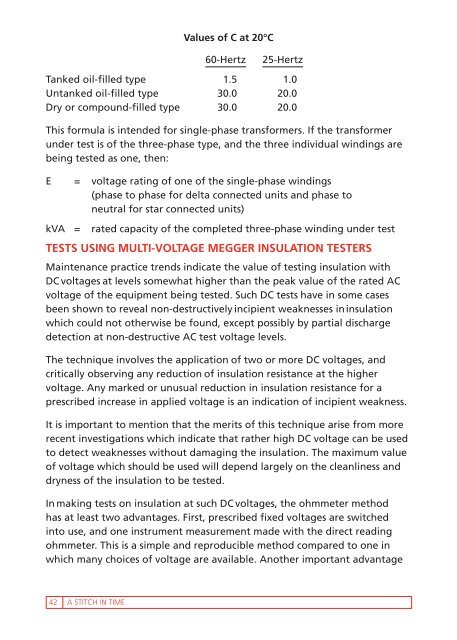“A Stitch in Time...”
You also want an ePaper? Increase the reach of your titles
YUMPU automatically turns print PDFs into web optimized ePapers that Google loves.
Values of C at 20°C<br />
60-Hertz<br />
25-Hertz<br />
Tanked oil-filled type 1.5 1.0<br />
Untanked oil-filled type 30.0 20.0<br />
Dry or compound-filled type 30.0 20.0<br />
This formula is <strong>in</strong>tended for s<strong>in</strong>gle-phase transformers. If the transformer<br />
under test is of the three-phase type, and the three <strong>in</strong>dividual w<strong>in</strong>d<strong>in</strong>gs are<br />
be<strong>in</strong>g tested as one, then:<br />
E = voltage rat<strong>in</strong>g of one of the s<strong>in</strong>gle-phase w<strong>in</strong>d<strong>in</strong>gs<br />
(phase to phase for delta connected units and phase to<br />
neutral for star connected units)<br />
kVA = rated capacity of the completed three-phase w<strong>in</strong>d<strong>in</strong>g under test<br />
Tests Us<strong>in</strong>g Multi-Voltage Megger Insulation Testers<br />
Ma<strong>in</strong>tenance practice trends <strong>in</strong>dicate the value of test<strong>in</strong>g <strong>in</strong>sulation with<br />
DC voltages at levels somewhat higher than the peak value of the rated AC<br />
voltage of the equipment be<strong>in</strong>g tested. Such DC tests have <strong>in</strong> some cases<br />
been shown to reveal non-destructively <strong>in</strong>cipient weaknesses <strong>in</strong> <strong>in</strong>sulation<br />
which could not otherwise be found, except possibly by partial discharge<br />
detection at non-destructive AC test voltage levels.<br />
The technique <strong>in</strong>volves the application of two or more DC voltages, and<br />
critically observ<strong>in</strong>g any reduction of <strong>in</strong>sulation resistance at the higher<br />
voltage. Any marked or unusual reduction <strong>in</strong> <strong>in</strong>sulation resistance for a<br />
prescribed <strong>in</strong>crease <strong>in</strong> applied voltage is an <strong>in</strong>dication of <strong>in</strong>cipient weakness.<br />
It is important to mention that the merits of this technique arise from more<br />
recent <strong>in</strong>vestigations which <strong>in</strong>dicate that rather high DC voltage can be used<br />
to detect weaknesses without damag<strong>in</strong>g the <strong>in</strong>sulation. The maximum value<br />
of voltage which should be used will depend largely on the cleanl<strong>in</strong>ess and<br />
dryness of the <strong>in</strong>sulation to be tested.<br />
In mak<strong>in</strong>g tests on <strong>in</strong>sulation at such DC voltages, the ohmmeter method<br />
has at least two advantages. First, prescribed fixed voltages are switched<br />
<strong>in</strong>to use, and one <strong>in</strong>strument measurement made with the direct read<strong>in</strong>g<br />
ohmmeter. This is a simple and reproducible method compared to one <strong>in</strong><br />
which many choices of voltage are available. Another important advantage<br />
42<br />
A STITCH IN TIME



